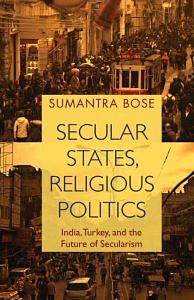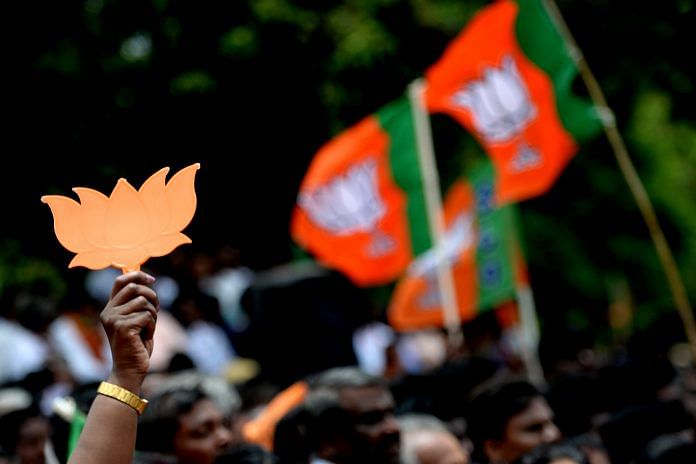In ‘Secular States, Religious Politics’, Sumantra Bose explains how the BJP has replaced the political idiom of secularism with a powerful one of nationalism.
The contemporary debates on secularism, especially in post-2014 India, often do not pay adequate attention to the crucial difference between secularism as a principle — which is fully worked out in the Constitution — and secularism as a political project — practiced in the realm of competitive electoral politics.
Of course, the articles of the Constitution and/or the judgments of the courts provide a legitimate language of politics; the practice of secularism as a political rhetoric is a highly unexplored area of political analysis.
The book, ‘Secular States, Religious Politics’, introduces us to this aspect of contemporary politics. The author narrates two highly insightful stories of secularism — India and Turkey — to pose a straightforward question: What is the future of secularism, especially in the non-Western world, which is affected by a powerful revival of religious politics?
The choice of India and Turkey as two comparable entities is very persuasive. The author argues that the conventional Western distinction between the church and the state (which is also interpreted as the imaginary dividing line between religion and politics) does not become a rigid principle in these two countries.
The state that evolved in independent India and Turkey functioned as “regulatory authority” that manages the religious affairs of the communities on a case-to-case basis following the broad principles of constitutional secularism. This configuration of polity — secular state and religious society — we are told, produced very specific kind of secular experiences.
Bose points out that the political impulse to associate Turkey with the Western world, especially with regard to political institutions, transformed the ideals of liberalism, modernity and secularism into the guiding principles for the state in Turkey. Hence, secularism as a political project emerged as a progressive resolve to get rid of the traditions of the Islamic past. This ‘secularism from above’ gradually ingrained in the political vocabulary of the ruling establishment, which used it to justify its authoritarianism in the name of modernity and secularism.
The rise of religious revivalism in Turkey in recent years, Bose suggests, should be seen in this backdrop. Although the new political elite relies heavily on the anti-secular rhetoric, it employs the old forms of authoritarianism to draw political legitimacy. According to Bose, “the replacement of secularist authoritarianism by a new form of authoritarian hegemony — ideologically anti-secular in being based on an Islamist brand of Turkish nationalism of a majoritarian and plebiscitary character, but also bearing remarkable continuities with its Kemalist predecessor’s state-centrism, zero-sum and winner-take-all view of power and politics and the cult of the strongman leader, with Erdogan replacing Ataturk”.
In the case of India, the book emphasises the nature of its constitutional democracy. Unlike Turkey, the post-Partition Indian state had to deal with the question of social and religious diversity. Interestingly, this diversity was not seen as a weakness in achieving the objective of nation-building. Instead, diversity was envisaged as a positive virtue by the Constituent Assembly, and precisely for this reason, a very context-specific notion of Indian secularism evolved.
In this framework of democracy and competitive electoral politics, the book situates the rise of Hindutva politics and its critique of secularism. Comparing the Atal Bihari Vajpayee-led NDA government between 1998 and 2004 with the present Narendra Modi government, the author suggests that the BJP establishment has replaced the political idiom of secularism with an equally powerful idiom of nationalism.
The author identifies three components of contemporary Hindutva, which he calls Hindutva 2.0.
In his view, the overemphasis on development makes Hindutva 2.0 very distinctive. Although the Modi government has inherited this language of development from previous Congress governments, especially the Indira Gandhi regime of 1970s, it has repackaged it to legitimise its majoritarian nationalism. This is the reason why the legitimate questioning of Modi’s development is often described as an anti-national act.
According to the author, the ‘empowerment of lower castes’ is the second ingredient of the contemporary Hindutva. This is a very conscious strategy to work out a grand alliance of Hindus to counter the Muslim vote-bank politics of non-BJP type. The appropriation of B.R. Ambedkar in the official state narrative of social justice could be seen as a revealing example of this trajectory.
Finally, Hindutva 2.0 tries to employ the regional diversity of India to construct a favourable narrative of cooperative federalism. This federalism, we must note, does entirely based on the conventional wisdom of division of powers between the Centre and the state; nor does it an outcome of the value-based coalition politics. This federalism is governed by the logic of what the BJP president Amit Shah calls “winnability”. BJP prefers to establish favourable equilibriums in the states for consolidating its position in Parliament.
The author, like all serious researchers, does not predict the future of secularism in any direct fashion. Instead, he asks us to look at the contemporary moment more seriously — not merely to understand the anti-secular politics of our time but also to trace the possibilities of alternative narratives of secularism.
 Hilal Ahmed is an associate professor, Centre for the Study of Developing Societies.
Hilal Ahmed is an associate professor, Centre for the Study of Developing Societies.




Too early to draw any definitive conclusions from one remarkable electoral victory. Hindutva does not resonate in the South or East. The Dalits have a troubled history with the Right, see little happening on the ground to give them comfort. The ability to carry different governments along, starting from Delhi itself, is yet to emerge, to give content to cooperative federalism. My heart tells me there is now growing realisation within the establishment itself that majoritarian excesses are proving counterproductive. Over seventy years, the Indian state was beginning to get quite a few things right. The Muslims, in economic terms, were little better off than the Dalits, yet they did not feel besieged. We need to reclaim a philosophy that has served a India well, provided a by and large harmonious framework – barring Kashmir and the north east – in which economic growth and national greatness can be pursued.